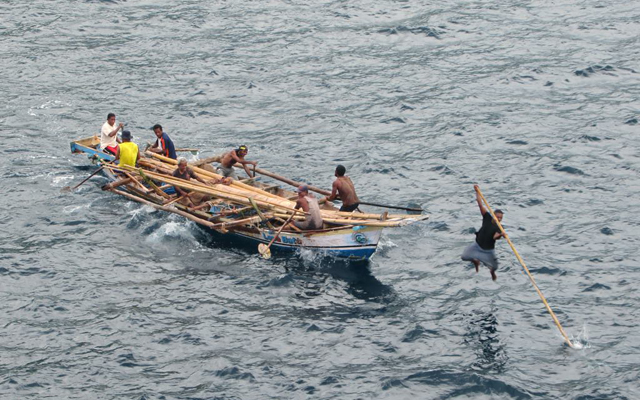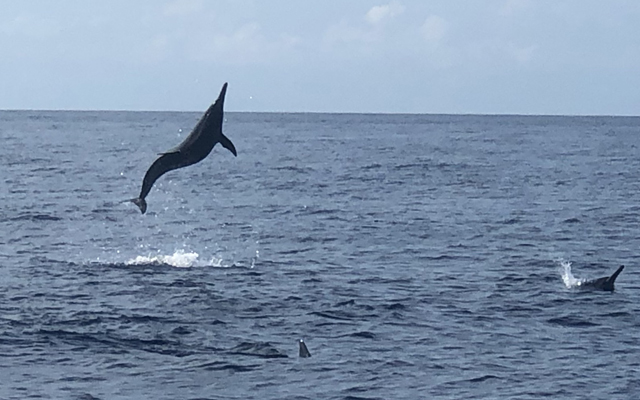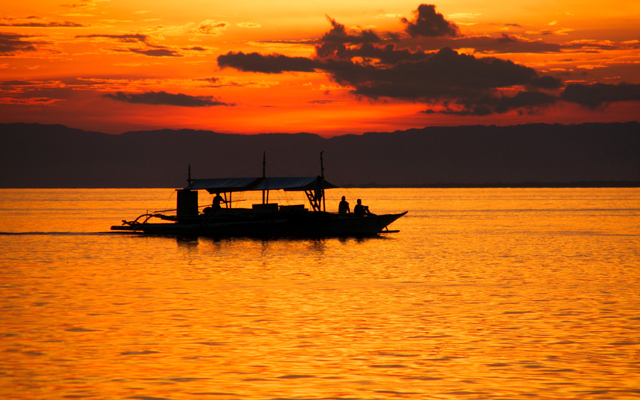(SPOT.ph) We set out from the glistening white sands of Alona Beach a little after daybreak, just as the sun was lazily claiming its spot against a startlingly blue sky. The weather was gorgeous, but no sooner had we reached the open waters of Bohol Sea did the gentle lapping of waves turned rough, causing our mid-sized boat to lurch and jerk every so often, with each dip and rise of the bow drenching us in a spray of saltwater.
We were headed to Pamilacan, an island fabled for its rich marine wildlife and frequent dolphin sightings, and if you’re luckier, you’d spot a whale or two gliding past without a care in the world. On that particular morning, though, we were warned that we may be up for a disappointment. Choppier waters mean less of a chance that we'd see dolphins.
More than an hour later and we’re still circling the waters surrounding the island waiting for some sign of the animals, enough reason to think that the trip was shaping up to be a futile attempt. One of our companions stood pensively by the boat’s bow: Joselino "Jojo" Baritua, the soft-spoken general manager of Pamilacan Island Dolphin and Whale Watching Tours, and the driving force behind marine life conservation on the island for the past 20 years. As we wait to see at least one of the 11 species of marine vertebrates that call these waters home, Baritua tells us about a certain way of life thought to have only existed elsewhere.

Bohol’s Whaling Communities
The Philippines has a long whaling history, stretching as far back as the 1600s, with Bohol home to at least two communities that actively engaged in whale hunting.
Pamilacan Island is one of these two well-documented whaling communities, the other area being Lila—both part of the municipality of Baclayon. In a 2013 study by Jo Marie V. Acebes of balyena.org, it was mentioned that Spanish missionaries from as early as the 16th century described how coastal Filipinos “relished eating whales.” Records show how, in the 19th century, British and American sperm whalers were lured by the bounty of the Bohol Sea and its promise of an abundant hunt. The exact origins of whaling in Bohol remains unknown, but according to the study, the practice in Lila began in the late 1800s and in Pamilacan in 1939.
This long and largely uninterrupted whale-hunting tradition which started as subsistence fishing ended in 1997, when a ban on whaling and whale shark hunting forced the practice to a screeching halt. Interestingly, there was also another game changer in 1997 that contributed to the death of whaling in Bohol.
[BigImage:{"caption":"Dolphin watching is now a popular activity in Barangay Baclayon, which used to have an active community of whale hunters.","photographer":"Shutterstock","image":"https://images.summitmedia-digital.com/spotph/images/2021/03/19/dolphin-watching-in-bohol2-1616129125.jpg"}]
From Whale Hunting to Dolphin Watching in Bohol
A 1997 conservation project turned the tide in favor of marine animals. "Twenty years ago, we organized this community para mahinto 'yong whale hunting nila. Kasi they do it traditionally. Naghu-hunt sila ng whales, dolphins, whale sharks, even manta rays. Way back [in] 1997, World Wildlife Fund Philippines launched a project here [on Pamilacan Island]. We called it Dolphin [and Whale] Watching [Village] Integrated Development Program para mabigyan sila ng alternative livelihood," recounted Baritua of the beginnings of what is now a sustainable means of livelihood and an inspiring conservation effort on the island. The program ended in 2000, but the efforts continue to this day.
The shift to an alternative form of livelihood was first met with lukewarm support, with some not too excited about abandoning what had long been considered an inextricable part of their culture. "Dati kinakain nila, binebenta nila, hinu-hunt nila. Halimbawa ‘yong whale shark, tapos they barter it during market day para sa mga local products: kamote, gabi. ‘Yong market day every Wednesday," Baritua explained.
He added, "No’ng simulan namin no’ng 1997, I was assigned then as World Wildlife Fund (WWF) Project Coordinator, medyo mahirap. Suntok sa buwan ‘yong ginagawa mo eh, kasi sanay sila sa easy money. Kasi dati ‘yong whale shark na hina-hunting nila, isang whale shark that would be sold on the island for P70,000. Isang whale shark lang ‘yon."
In time, however, the WWF program turned out to be a success story. "No'ng mahinto (‘yong whaling) way back [in] 1997, no’ng inintroduce namin ‘yung dolphin watching, ayaw nila eh. Later on, we were able to convince them na mas maganda ito. Kasi one time in 2010, nakita namin ‘yong blue whale. Dati kinakatay nila yun, mabenta lang ‘yon nang P20,000, lahat-lahat na ‘yong karne. But during that time, ‘yong nakita for the first time na na-promote na ‘yong [dolphin watching], kumita sila ng more than P100,000 in two weeks. Win-win. [Kung] kinatay [nila] ‘yon P20,000 lang. Ngayon, nagdala tayo ng mga bisita, kumita sila nang more than P100,000."
But more than the exponential increase in profits, the best thing about the shift to a more sustainable form of livelihood is that it aids in the conservation of these majestic marine creatures. The whale hunters are now the whale watchers.
“The good thing is buhay ‘yong mga hayop at may chance pang bumalik ulit kasi migratory sila.” Baritua added.
[BigImage:{"caption":"The bountiful coral island of Pamilacan is home to more than 11 species of dolphins and whales.","photographer":"Courtesy of The EON Group","image":"https://images.summitmedia-digital.com/spotph/images/2021/03/19/dolphin-watching-in-bohol3-1616129314.jpg"}]
A Better Appreciation for Marine Life
This shift also inspired in the locals a deeper appreciation for the environment, particularly marine life: "Totally may shift. Makita mo rin ‘yong appreciation ng mga tao. Kumbaga dati, they treat the marine mammals, especially the dolphins as competitors no’ng mga mangingisda. Kasi pag nangisda sila, [kung saan] ‘yong matang baka [cow-eyed scad fish] nando’n din ‘yong dolphins, kinakain ‘yong target fish nila. Kaya inaaway nila ‘yong [dolphins], kasi kakumpetensiya nila. But right now, when you cross the strait from this island to Baclayon, the [fishermen] would gladly say, ‘O, may nakita kaming dolphins!’ Dati they treat them as competitors, ngayon na-appreciate na nila.”"
Baritua shared that there were also locals who were indifferent to marine conservation, but after their tireless efforts in educating the community, the people eventually developed a love and concern for the ocean and the creatures that call it home. "After many years of efforts in educating, organizing work, do’n nila nakita ‘yong importance ng marine mammal conservation. Pwede pala na kumita tayo nang hindi natin kinakatay [ang marine animals]."
More than 20 years since the Dolphin Watching Integrated Development Program changed the cultural landscape of Pamilacan Island from a culture of hunting to what is now a culture of conservation, Baritua remains proud of his group’s efforts and achievements.
"We were able to successfully develop the community na hindi na sila mag-hunt. Even before the pandemic, 70% ng mga tao dito ay relying more on tourism. These are the snorkeling guides, dolphin watching guides, then mga massage therapists, we also train them. Then may mga accommodation dito sa island. After the tour, daan kami diyan [sa isla], diyan kakain ang mga guests namin. We bring them to the snorkeling sites, kasi maganda ang corals dito e, at saka maraming isda. Aside from the corals at isda, meron din mga turtles, kumbaga kumpleto—nag-island hopping ka, nag-dolphin watching plus snorkeling."
However, a global pandemic of staggering magnitude and the tight restrictions that came in its wake brought the primary source of livelihood of this idyllic community to a chilling standstill.

A Nosedive in Tourism Revenues, a Loss of Livelihood
Now a year into what is considered one of the world’s strictest and longest lockdowns, tourism in Bohol remains in a slump. "Totally bagsak ngayong pandemic. Nung February [2020] pa, no’ng nagka-first COVID case, nagkataon naman pumunta pa rito ‘yo’ng Chinese na bata. As in bagsak talaga," he shared. Pre-pandemic, the island’s daily average was around 10 to 20 boats going on trips with 20 guides plus more than 100 snorkeling guides.
This heartbreaking loss of livelihood forced many in the tourism business to go back to fishing, even those who have never done it for a living before. "Bumalik sila sa pangingisda. Kaso lang, ‘yong iba na nasanay na sa mga tours, nahihirapan silang bumalik do’n sa pangingisda. Kasi kailangan mo ng bangka, kailangan mong pumalaot ka, pati ‘yong timing kung humuli ng isda kasi hindi naman may bingwit ka makahuhuli ka na agad. (Kailangan ng) technique din."
Baritua said that during peak seasons for tours, guides could earn as much as P14,000 a month. These days, they only take home between P2,000 and P3,000 a month through fishing.
Also read: How Bohol Is Bouncing Back, One Tour at a Time

Buoyed by Optimism and Hope
The current situation remains bleak, but Baritua is optimistic that tourism will pick up again, albeit in two to three years. "Malaking kawalan talaga, hopefully, little by little we could start bringing back tourists. We just have to follow protocols, katulad ng ginagawa natin dito ngayon."
A few minutes after our conversation ended and a good two hours from the time we set sail, pods of dolphins suddenly appeared to the immense delight of everyone onboard. That unforgettable sight of some of the world’s most enchanting creatures, which came at a point when almost all hope was lost, served as a beautiful reminder that great things await the patient and the hopeful.
Baritua and the locals on Pamilacan Island have long been patiently waiting for the tide to turn in their favor once more, at times almost giving up, but certainly not losing hope that the time would come when the magnificent marine mammals of Bohol Sea would put a smile on more faces again. Hopefully, soon.
Source: Spot PH
No comments:
Post a Comment